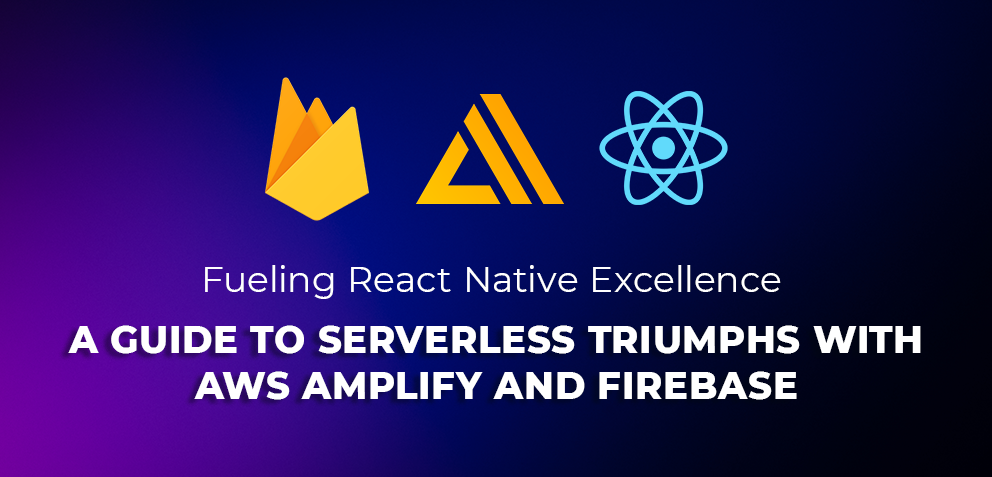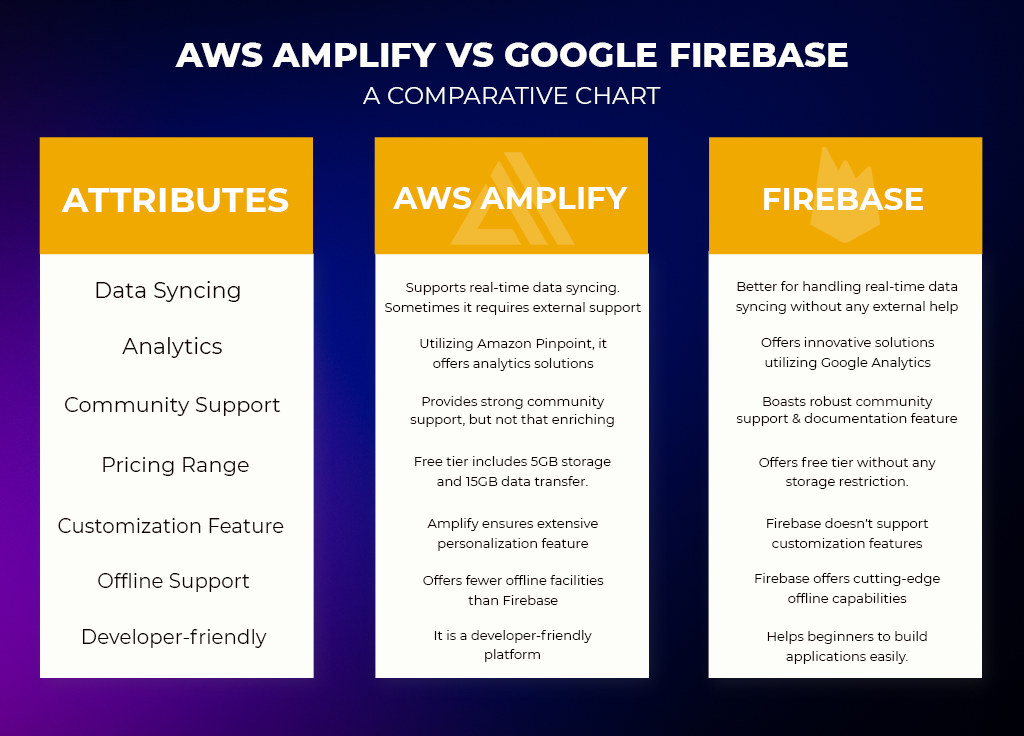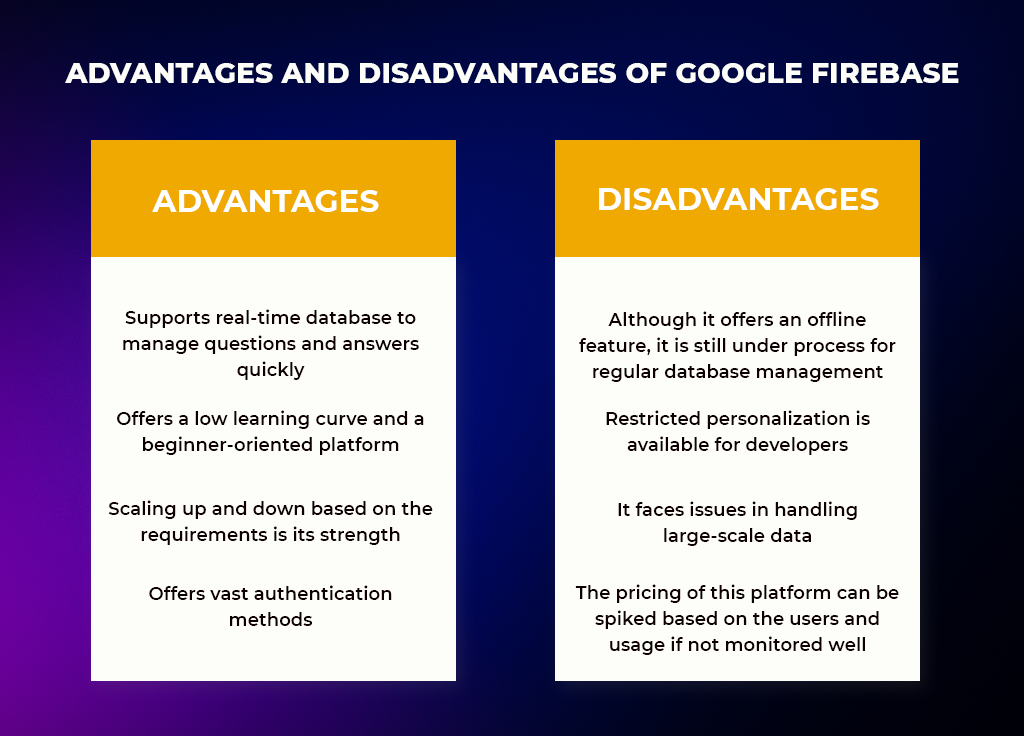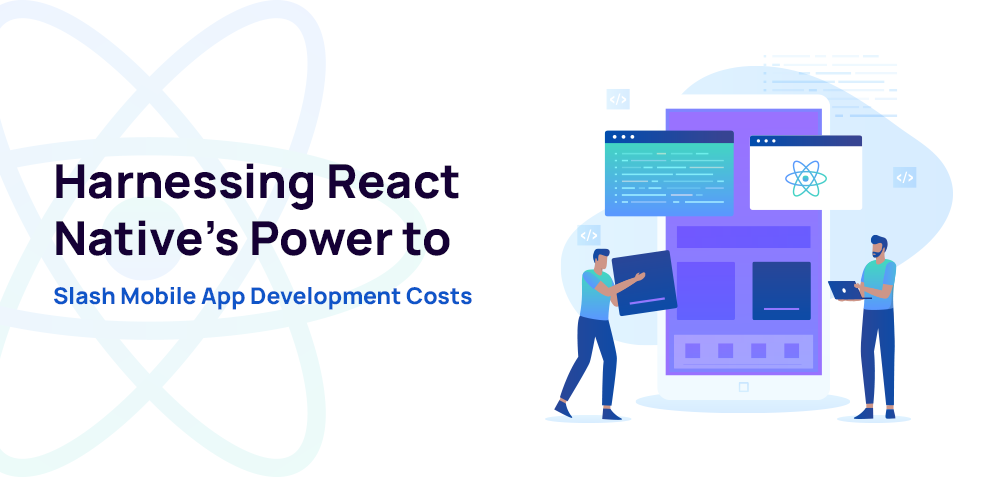React Native App Development with AWS Amplify or Firebase

Table Of Contents
 Stay In-the-loop
Stay In-the-loop
Get fresh tech & marketing insights delivered right to your inbox.
Share this Article
Tags
Category
- .Net Developer
- Adtech
- Android App Development
- API
- App Store
- Artificial Intelligence
- Blockchain Development
- Chatbot Development
- CMS Development
- Cybersecurity
- Data Security
- Dedicated Developers
- Digital Marketing
- Ecommerce Development
- Edtech
- Fintech
- Flutter app development
- Full Stack Development
- Healthcare Tech
- Hybrid App Development
- iOS App Development
- IT Project Management
- JavaScript development
- Laravel Development
- Magento Development
- MEAN Stack Developer
- MERN Stack Developer
- Mobile App
- Mobile App Development
- Nodejs Development
- Progressive Web Application
- python development
- QA and testing
- Quality Engineering
- React Native
- SaaS
- SEO
- Shopify Development
- Software Development
- Software Outsourcing
- Staff Augmentation
- UI/UX Development
- Web analytics tools
- Wordpress Development
In the dynamic realm of React Native app development services, the paradigm shift towards serverless architecture has emerged as a game-changer. As businesses strive for agility, AWS Amplify and Firebase stand out as the titans reshaping the landscape.
Serverless, contrary to its name, doesn’t mean abandoning servers; it’s about offloading the burden to cloud behemoths, empowering developers to focus on innovation. Serverless architecture comes with a pay-as-you-go feature, which means you have to pay for the service once it’s taken, assisting you to build scalable and flexible applications in React Native. However, for that, you should hire React Native developers.
In this exploration, we delve into the strategic intricacies of AWS Amplify and Firebase, dissecting their features to empower your React Native endeavors. Welcome to the vanguard of serverless architecture—where coding accelerates, deployment quickens, and the cloud becomes the virtuoso orchestrator.
Benefits of Serverless Architecture in React Native App Development
The Serverless architecture in React Native is a cornerstone and comes with multiple benefits.
- Seamless Scalability: Seamless and effective scalability is one of the prime benefits of serverless architecture in React Native. It is equipped with diversely adjusted resources, resulting in the app being more responsive and scalable despite the growing user count of this technology.
- More Productivity: If you’re familiar with servers, you know the pain of their maintenance, which takes a toll on both your energy and time, right? However, serverless architecture minimizes operational burdens, ensuring streamlined workflow without any interruption while buying optimized time for more innovative ideas.
- Faster Application Development Phase: Serverless architecture supports developers in the quick iteration and deployment phase, meaning they can hit the ground running. Amazing, right? This enables developers to be more focused on making user experience compelling and smooth with increased satisfaction. However, hire a React Native development service for a faster development process.
- Cost-effective: Traditional server service has overhead costs, making charges for uptime for unused resources as well. But serverless architecture believes in the mantra that ‘if it’s running, then only you’ll pay’, saving operational costs. Isn’t it cool?
- Flexible Feature: Crafting a flexible application is every developer’s dream. For that, utilizing serverless architecture has become their favorite these days. With serverless architecture in React Native, you unlock the door of robust, state-of-the-art, and advanced third-party services easily.
RELATED READ: The Battle of Stacks: MEAN vs. MERN – Which One to Choose
AWS Amplify vs Google Firebase in React Native App Development: A Comparative Chart

Wondering what is the difference between AWS Amplify and Firebase? We’ll delve into the detailed comparison between these two in the later section. Here, let’s have a quick look at the side-by-side comparison chart of AWS Amplify vs. Google Firebase.
AWS Amplify in React Native App Development: Key Features and Different Facets
AWS is a full-stack development environment that enables web and mobile developers to create, host, and deploy full-stack applications on Amazon Web Service (AWS), avoiding the need for a cloud expert. Leveraging extensive AWS services, AWS Amplify seamlessly and quickly integrates backend functionalities with React Native via a visual interface or command line.
With AWS Amplify, React Native experts can curate cloud-native applications that excel in providing near-native experience to users, assisting organizations in offering apps on AWS. This tool enhances app development flexibility with faster speed and provides top-notch apps, catering to diverse audiences across the globe while fostering growth.
Key Features
AWS Amplify offers a set of standout features that can stimulate the React Native app development, streamlining the entire development progress. So, let’s check those key features.
- Authentication
AWS Amplify supports advanced authentication functionality powered by robust authentication providers, such as custom authentication flows, Amazon Cognito, social identity providers, etc., resulting in smooth user login, access control, and registration implementation in mobile apps.
- Hosting
AWS Amplify offers hosting functionality that enables you to deploy frontend codes from the Amplify CLI seamlessly. In fact, it provides smooth AWS CloudFront integration, ensuring faster content delivery and seamless global distribution.
- Data Storage System
The AWS Amplify framework empowers you with extensive storage management options to store vital information, including Amazon DynamoDB for NoSQL database necessity and Amazon S3.
- Seamless Real-time Data
Utilizing AWS AppSync, the Amplify framework ensures you unlock real-time data functionality easily. So, how can it be beneficial? Well, it is significantly beneficial for building chat apps, live feeds, collaborative apps, and more.
- Serverless Functionality
The AWS Lambda platform offers the ability to create serverless functionality and integrate them into the project easily. This feature is extremely essential for running and managing backend logic without using servers. For that, hire React Native developers.
- GraphQL API
This is another unique feature of AWS Amplify, ensuring you smoothly and efficiently define and refine the data models using GrapgQL schema. It can automatically generate APIs for the front end, assisting with configuration and data management.
- Monitor and Analyze Features
With AWS Amplify, you can monitor and analyze application performance and user behavior patterns smoothly to foster and optimize overall application performance, improving user retention and conversion rate.
Additionally, AWS Amplify offers AR and VR, offline synchronization, notifications, and features.
AWS Amplify Facets
The multiple facets of AWS Amplify include the following.
- Amplify CLI
Amplify CLI manages and configures a full-stack application backend as a toolchain while using a local desktop. This tool supports you in creating interactive workflows and server-to-the-cloud functionality.
- Amplify UI Components
Amplify UI components, an open-source design system incorporates cloud-oriented components to help build applications smoothly, catering to customers with engaging front-end solutions.
- Amplify Studio
Being the visual interface, Amplify Studio ensures a point-and-click situation to create full-stack applications for both frontend and backend effectively. It maintains user authentication processes alongside content management and integrates AWS resources in the application for super smooth functionality.
- Amplify Libraries
With these open-source client libraries, creating cloud-oriented mobile and web applications is extremely smooth and quick.
- Amplify Web Hosting
AWS Amplify web hosting supports solely maintained CI/CD service to host static and server-side rendered applications.

Supercharge Your App Development with React Native
Let Magicminds bring your vision to life and ensure the app's high performance with AWS Amplify and Firebase.
Google Firebase in React Native App Development: Key Features and Different Facets
Powered by Google, Firebase is a cutting-edge and next-generation application development platform. Its highly innovative service ensures a compelling user experience and, thus, satisfaction. Working as your API, server, and data store, Firebase is a one-stop solution for you to build highly scalable and flexible applications.
Supporting developers across the globe with robust tools and libraries, this platform is suitable for creating boosted user engagement. As it is backed by Google, you can rest assured that it comes with the latest updates and utmost security regularly.
Key Features
So, what are the main features of Firebase?
- Authentication
Firebase comes with an extensive authentication service that easily incorporates phone numbers, social logins, email and password, etc authentication. Taking advantage of this feature, you can integrate user authentication systems in your mobile and web applications.
- Storage
Firebase’s storage system is specially curated for storing user-defined content, including images, videos, and files easily. Combined with Firebase Authentication, it provides more secure and faster access control. Hire React Native experts for smooth application development.
- Cloud Firestore
Utilizing Cloud Firestore, a NoSQL database, Firebase supports robust data modeling and answering facility. Besides, Firebase Cloud helps you to maintain and deploy serverless architecture efficiently.
- Hosting
Firebase offers a robust and quick hosting solution for web applications, including a CDN process to quicken the content delivery process.
- Seamless Analytics
With Firebase Analytics, you can get powerful insights into your application’s performance and user behavior, enabling you to understand how your application is dealing with your customers. Hiring React Native programmers can help you to build more scalable applications.
- More Real-time Database
Hosted by a NoSQL database, Firebase offers real-time data synchronization, making it the ideal platform for application development that requires quick updates.
Different Facets
The multiple parts of Google Firebase are mentioned below.
- Crashlytics
Crashlytics is an efficient and smart crash report tool to support dedicated React Native developers in prioritizing, monitoring, analyzing, and resolving issues.
- Test Lab
Being a cloud infrastructure environment, Firebase Test Lab offers app testing that includes screenshots, logs, videos, etc..
- Analytics
Integrating with Google Analytics, Firebase offers robust and unrestricted reporting for different Firebase SDK events.
- App Distribution
Firebase App Distribution gives you a compact view of the beta testing program for Android and iOS.
- Performance Monitoring
Utilizing Performance Monitoring means getting active and real-time insights into web and mobile app performance.

AWS Amplify vs Google Firebase in React Native App Development: A Detailed Comparison
Find the detailed comparison below.
Real-time Data Syncing
Honestly, we can’t overstate enough the fact that most full-stack cloud solutions offer real-time data synchronization. Likewise, AWS Amplify also seamlessly incorporates real-time data syncing. To utilize this opportunity, Amplify prefers AppSync to support data synchronization. Similarly, additional support and external solutions to improve real-time data synchronization are required too.
However, on the other hand, Google Firebase comes with native support for real-time data synchronization processes, meaning that you can avoid using external or additional solutions.
Firebase wins hearts for native real-time data syncing, offering top-notch service for cloud-hosted app development.
Seamless Storage
Storing all the sensitive data in S3 storage, AWS Amplify, securing your application data in the AWS environment, and you’re entirely locked in this application environment.
In the case of Firebase, it stores all the data safely in Google Cloud. However, you can upgrade to other environments from Google Cloud, too.
Choose AWS Amplify for complete AWS environment lock-in. Opt for Firebase if it’s your first app and you’re planning full-stack development, staying connected with Google.
Analytical Difference
The analytical difference is one of the major comparison aspects in the AWS Amplify vs Firebase framework. AWS Amplify best practices Amazon Pinpoint application to ensure seamless analytical solutions. You can easily build custom functionalities and monitor activities using analytics support. What’s more striking is that it can integrate smoothly with other AWS services.
On the other hand, Firebase directly includes Google Analytics, providing you with out-of-pocket solutions that can smoothly meet the analytics requirements for the application. Firebase enables a real-time reporting facility while integrating with mobile and web applications efficiently. Isn’t it amazing?
Choose Firebase for state-of-the-art solutions and real-time reporting. Opt for Amplify if you require custom features and intricate event triggers.
More Scalability
Scalability is one of the major differences between Amplify and Firebase. AWS Amplify supports a ‘pay-as-you-use’ facility, adding scale-up and down options. This means you can scale your application according to your requirements smoothly. For that, you must hire a React Native expert.
However, Firebase offers a NoSQL database, helping you to scale up and down your application using this platform.
So, the final verdict is as Firebase provides database scalability and flexibility with seamless functionality, it can be a good option for you.
Strong Community Support
AWS Amplify holds a strong community. Please note that community support is not that enriched or vast.
However, Firebase is powered by the Google Cloud platform. Needless to say, it’s the powerhouse of solid community support backed up by skilled React Native programmers.
In the AWS Amplify vs Firebase battle, Firebase wins our hearts with extensive community and documentation support, aiding in robust application development.
Personalization
AWS Amplify empowers you with enriched personalization features for the developer’s platform and analytics, meaning you can add tailored features to your application according to your requirements with this platform.
Firebase limits personalization options, making Amplify the go-to choice for flexibility and tailored features.
Pricing Plan
The AWS Amplify vs Firebase pricing is a matter of debate. Amplify offers a free tier that covers 1 year with a 5GB storage facility, supporting 1000 developers and 15GB data transfer features. It includes a pay-as-you-go option that counts as a $0.01/minute build-up, which means $0.023/GB per month.
On the other hand, Firebase supports the free tier without any storage limitation, offering cost-effective development. Besides, it comes with Blaze, which is a pay-as-you-go plan, Spark plan, etc., which is ideal for tiny and heavy application development. So, indeed, you should opt for Firebase, depending on the pricing and storage capacity.
Offline Support Feature
For AWS Amplify offline support, you should leverage options, including AWS AppSync and AWS Amplify DataSTore.
On the other hand, Firebase enables you with out-of-state opportunities to handle offline activities. This framework can enhance your application build-up with offline capabilities.
So, it’s obvious that Firebase has won the battle in offline support features in comparison to Amplify.
Contribution of Developers
AWS Amplify is considered the easiest, smoothest, and most developer-friendly platform utilizing tools, such as CLI and web console, for streamlined and efficient application development. Besides, React Native app developers create multiple platform services with AWS Amplify React Native frameworks.
However, Firebase is beginner developer-friendly and supports cross-platform frameworks easily to create native-oriented multi-platform applications. That’s why, to our knowledge, opting for Firebase is an ideal choice if you lack access to other AWS platforms.
Need to Build Smarter, Secured, & Faster React Native Apps?
Our top-notch React Native developers can ensure scalability with impenetrable security, unparalleled performance, and a seamless user experience.
Hire Our Developers Now!AWS Amplify or Firebase: Which is Suitable for Your React Native App Development?
Are you still wondering about which is better, AWS or Firebase? We’ve thoroughly compared these two platforms, depending on different aspects. In this debate, Firebase offers more scalability and flexibility; however, Amplify is better for tailored applications. It’s tough to choose any of the platforms. We’ve bought the pros and cons of both of the platforms. Now, it’s up to you. According to your application requirements, you can choose between any of these platforms.
Magicminds is powered by the ideal team, tools, and infrastructure to support seamless application development leveraging AWS Amplify and Firebase therefore if you want to create a flexible, accessible, and scalable application, contact us today!
In the dynamic realm of React Native app development services, the paradigm shift towards serverless architecture has emerged as a game-changer. As businesses strive for agility, AWS Amplify and Firebase stand out as the titans reshaping the landscape.
Serverless, contrary to its name, doesn’t mean abandoning servers; it’s about offloading the burden to cloud behemoths, empowering developers to focus on innovation. Serverless architecture comes with a pay-as-you-go feature, which means you have to pay for the service once it’s taken, assisting you to build scalable and flexible applications in React Native. However, for that, you should hire React Native developers.
In this exploration, we delve into the strategic intricacies of AWS Amplify and Firebase, dissecting their features to empower your React Native endeavors. Welcome to the vanguard of serverless architecture—where coding accelerates, deployment quickens, and the cloud becomes the virtuoso orchestrator.
Benefits of Serverless Architecture in React Native App Development
AWS Amplify vs Google Firebase in React Native App Development: A Comparative Chart
- AWS Amplify: Key Features and Different Facets
- Advantages and Disadvantages of AWS Amplify
- Google Firebase: Key Features and Different Facets
- Advantages and Disadvantages of Google Firebase
AWS Amplify vs Google Firebase in React Native App Development: A Detailed Comparison
AWS Amplify or Firebase: Which is Suitable for Your React Native App Development?
Benefits of Serverless Architecture in React Native App Development
The Serverless architecture in React Native is a cornerstone and comes with multiple benefits.
- Seamless Scalability: Seamless and effective scalability is one of the prime benefits of serverless architecture in React Native. It is equipped with diversely adjusted resources, resulting in the app being more responsive and scalable despite the growing user count of this technology.
- More Productivity: If you’re familiar with servers, you know the pain of their maintenance, which takes a toll on both your energy and time, right? However, serverless architecture minimizes operational burdens, ensuring streamlined workflow without any interruption while buying optimized time for more innovative ideas.
- Faster Application Development Phase: Serverless architecture supports developers in the quick iteration and deployment phase, meaning they can hit the ground running. Amazing, right? This enables developers to be more focused on making user experience compelling and smooth with increased satisfaction. However, hire a React Native development service for a faster development process.
- Cost-effective: Traditional server service has overhead costs, making charges for uptime for unused resources as well. But serverless architecture believes in the mantra that ‘if it’s running, then only you’ll pay’, saving operational costs. Isn’t it cool?
- Flexible Feature: Crafting a flexible application is every developer’s dream. For that, utilizing serverless architecture has become their favorite these days. With serverless architecture in React Native, you unlock the door of robust, state-of-the-art, and advanced third-party services easily.
RELATED READ: The Battle of Stacks: MEAN vs. MERN – Which One to Choose
AWS Amplify vs Google Firebase in React Native App Development: A Comparative Chart

Wondering what is the difference between AWS Amplify and Firebase? We’ll delve into the detailed comparison between these two in the later section. Here, let’s have a quick look at the side-by-side comparison chart of AWS Amplify vs. Google Firebase.
AWS Amplify in React Native App Development: Key Features and Different Facets
AWS is a full-stack development environment that enables web and mobile developers to create, host, and deploy full-stack applications on Amazon Web Service (AWS), avoiding the need for a cloud expert. Leveraging extensive AWS services, AWS Amplify seamlessly and quickly integrates backend functionalities with React Native via a visual interface or command line.
With AWS Amplify, React Native experts can curate cloud-native applications that excel in providing near-native experience to users, assisting organizations in offering apps on AWS. This tool
enhances app development flexibility with faster speed and provides top-notch apps, catering to diverse audiences across the globe while fostering growth.
Key Features
AWS Amplify offers a set of standout features that can stimulate the React Native app development, streamlining the entire development progress. So, let’s check those key features.
- Authentication
AWS Amplify supports advanced authentication functionality powered by robust authentication providers, such as custom authentication flows, Amazon Cognito, social identity providers, etc., resulting in smooth user login, access control, and registration implementation in mobile apps.
- Hosting
AWS Amplify offers hosting functionality that enables you to deploy frontend codes from the Amplify CLI seamlessly. In fact, it provides smooth AWS CloudFront integration, ensuring faster content delivery and seamless global distribution.
- Data Storage System
The AWS Amplify framework empowers you with extensive storage management options to store vital information, including Amazon DynamoDB for NoSQL database necessity and Amazon S3.
- Seamless Real-time Data
Utilizing AWS AppSync, the Amplify framework ensures you unlock real-time data functionality easily. So, how can it be beneficial? Well, it is significantly beneficial for building chat apps, live feeds, collaborative apps, and more.
- Serverless Functionality
The AWS Lambda platform offers the ability to create serverless functionality and integrate them into the project easily. This feature is extremely essential for running and managing backend logic without using servers. For that, hire React Native developers.
- GraphQL API
This is another unique feature of AWS Amplify, ensuring you smoothly and efficiently define and refine the data models using GrapgQL schema. It can automatically generate APIs for the front end, assisting with configuration and data management.
- Monitor and Analyze Features
With AWS Amplify, you can monitor and analyze application performance and user behavior patterns smoothly to foster and optimize overall application performance, improving user retention and conversion rate.
Additionally, AWS Amplify offers AR and VR, offline synchronization, notifications, and features.
AWS Amplify Facets
The multiple facets of AWS Amplify include the following.
- Amplify CLI
Amplify CLI manages and configures a full-stack application backend as a toolchain while using a local desktop. This tool supports you in creating interactive workflows and server-to-the-cloud functionality.
- Amplify UI Components
Amplify UI components, an open-source design system incorporates cloud-oriented components to help build applications smoothly, catering to customers with engaging front-end solutions.
- Amplify Studio
Being the visual interface, Amplify Studio ensures a point-and-click situation to create full-stack applications for both frontend and backend effectively. It maintains user authentication processes alongside content management and integrates AWS resources in the application for super smooth functionality.
- Amplify Libraries
With these open-source client libraries, creating cloud-oriented mobile and web applications is extremely smooth and quick.
- Amplify Web Hosting
AWS Amplify web hosting supports solely maintained CI/CD service to host static and server-side rendered applications.

Google Firebase in React Native App Development: Key Features and Different Facets
Powered by Google, Firebase is a cutting-edge and next-generation application development platform. Its highly innovative service ensures a compelling user experience and, thus, satisfaction. Working as your API, server, and data store, Firebase is a one-stop solution for you to build highly scalable and flexible applications.
Supporting developers across the globe with robust tools and libraries, this platform is suitable for creating boosted user engagement. As it is backed by Google, you can rest assured that it comes with the latest updates and utmost security regularly.
Key Features
So, what are the main features of Firebase?
- Authentication
Firebase comes with an extensive authentication service that easily incorporates phone numbers, social logins, email and password, etc authentication. Taking advantage of this feature, you can integrate user authentication systems in your mobile and web applications.
- Storage
Firebase’s storage system is specially curated for storing user-defined content, including images, videos, and files easily. Combined with Firebase Authentication, it provides more secure and faster access control. Hire React Native experts for smooth application development.
- Cloud Firestore
Utilizing Cloud Firestore, a NoSQL database, Firebase supports robust data modeling and answering facility. Besides, Firebase Cloud helps you to maintain and deploy serverless architecture efficiently.
- Hosting
Firebase offers a robust and quick hosting solution for web applications, including a CDN process to quicken the content delivery process.
- Seamless Analytics
With Firebase Analytics, you can get powerful insights into your application’s performance and user behavior, enabling you to understand how your application is dealing with your customers. Hiring React Native programmers can help you to build more scalable applications.
- More Real-time Database
Hosted by a NoSQL database, Firebase offers real-time data synchronization, making it the ideal platform for application development that requires quick updates.
Different Facets
The multiple parts of Google Firebase are mentioned below.
- Crashlytics
Crashlytics is an efficient and smart crash report tool to support dedicated React Native developers in prioritizing, monitoring, analyzing, and resolving issues.
- Test Lab
Being a cloud infrastructure environment, Firebase Test Lab offers app testing that includes screenshots, logs, videos, etc..
- Analytics
Integrating with Google Analytics, Firebase offers robust and unrestricted reporting for different Firebase SDK events.
- App Distribution
Firebase App Distribution gives you a compact view of the beta testing program for Android and iOS.
- Performance Monitoring
Utilizing Performance Monitoring means getting active and real-time insights into web and mobile app performance.

AWS Amplify vs Google Firebase in React Native App Development: A Detailed Comparison
Find the detailed comparison below.
Real-time Data Syncing
Honestly, we can’t overstate enough the fact that most full-stack cloud solutions offer real-time data synchronization. Likewise, AWS Amplify also seamlessly incorporates real-time data syncing. To utilize this opportunity, Amplify prefers AppSync to support data synchronization. Similarly, additional support and external solutions to improve real-time data synchronization are required too.
However, on the other hand, Google Firebase comes with native support for real-time data synchronization processes, meaning that you can avoid using external or additional solutions.
Firebase wins hearts for native real-time data syncing, offering top-notch service for cloud-hosted app development.
Seamless Storage
Storing all the sensitive data in S3 storage, AWS Amplify, securing your application data in the AWS environment, and you’re entirely locked in this application environment.
In the case of Firebase, it stores all the data safely in Google Cloud. However, you can upgrade to other environments from Google Cloud, too.
Choose AWS Amplify for complete AWS environment lock-in. Opt for Firebase if it’s your first app and you’re planning full-stack development, staying connected with Google.
Analytical Difference
The analytical difference is one of the major comparison aspects in the AWS Amplify vs Firebase framework. AWS Amplify best practices Amazon Pinpoint application to ensure seamless analytical solutions. You can easily build custom functionalities and monitor activities using analytics support. What’s more striking is that it can integrate smoothly with other AWS services.
On the other hand, Firebase directly includes Google Analytics, providing you with out-of-pocket solutions that can smoothly meet the analytics requirements for the application. Firebase enables a real-time reporting facility while integrating with mobile and web applications efficiently. Isn’t it amazing?
Choose Firebase for state-of-the-art solutions and real-time reporting. Opt for Amplify if you require custom features and intricate event triggers.
More Scalability
Scalability is one of the major differences between Amplify and Firebase. AWS Amplify supports a ‘pay-as-you-use’ facility, adding scale-up and down options. This means you can scale your application according to your requirements smoothly. For that, you must hire a React Native expert.
However, Firebase offers a NoSQL database, helping you to scale up and down your application using this platform.
So, the final verdict is as Firebase provides database scalability and flexibility with seamless functionality, it can be a good option for you.
Strong Community Support
AWS Amplify holds a strong community. Please note that community support is not that enriched or vast.
However, Firebase is powered by the Google Cloud platform. Needless to say, it’s the powerhouse of solid community support backed up by skilled React Native programmers.
In the AWS Amplify vs Firebase battle, Firebase wins our hearts with extensive community and documentation support, aiding in robust application development.
Personalization
AWS Amplify empowers you with enriched personalization features for the developer’s platform and analytics, meaning you can add tailored features to your application according to your requirements with this platform.
Firebase limits personalization options, making Amplify the go-to choice for flexibility and tailored features.
Pricing Plan
The AWS Amplify vs Firebase pricing is a matter of debate. Amplify offers a free tier that covers 1 year with a 5GB storage facility, supporting 1000 developers and 15GB data transfer features. It includes a pay-as-you-go option that counts as a $0.01/minute build-up, which means $0.023/GB per month.
On the other hand, Firebase supports the free tier without any storage limitation, offering cost-effective development. Besides, it comes with Blaze, which is a pay-as-you-go plan, Spark plan, etc., which is ideal for tiny and heavy application development. So, indeed, you should opt for Firebase, depending on the pricing and storage capacity.
Offline Support Feature
For AWS Amplify offline support, you should leverage options, including AWS AppSync and AWS Amplify DataSTore.
On the other hand, Firebase enables you with out-of-state opportunities to handle offline activities. This framework can enhance your application build-up with offline capabilities.
So, it’s obvious that Firebase has won the battle in offline support features in comparison to Amplify.
Contribution of Developers
AWS Amplify is considered the easiest, smoothest, and most developer-friendly platform utilizing tools, such as CLI and web console, for streamlined and efficient application development. Besides, React Native app developers create multiple platform services with AWS Amplify React Native frameworks.
However, Firebase is beginner developer-friendly and supports cross-platform frameworks easily to create native-oriented multi-platform applications. That’s why, to our knowledge, opting for Firebase is an ideal choice if you lack access to other AWS platforms.
AWS Amplify or Firebase: Which is Suitable for Your React Native App Development?
Are you still wondering about which is better, AWS or Firebase? We’ve thoroughly compared these two platforms, depending on different aspects. In this debate, Firebase offers more scalability and flexibility; however, Amplify is better for tailored applications. It’s tough to choose any of the platforms. We’ve bought the pros and cons of both of the platforms. Now, it’s up to you. According to your application requirements, you can choose between any of these platforms.
Magicminds is powered by the ideal team, tools, and infrastructure to support seamless application development leveraging AWS Amplify and Firebase therefore if you want to create a flexible, accessible, and scalable application, contact us today!


